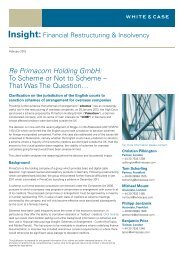Mexican Legal Framework of Business Insolvency - White & Case
Mexican Legal Framework of Business Insolvency - White & Case
Mexican Legal Framework of Business Insolvency - White & Case
You also want an ePaper? Increase the reach of your titles
YUMPU automatically turns print PDFs into web optimized ePapers that Google loves.
filing such pro<strong>of</strong>s <strong>of</strong> claim and indicate whether secured creditors are required to file<br />
pro<strong>of</strong>s <strong>of</strong> claim [LCM 291].<br />
b. Appeal<br />
The judgment that declares the debtor en concurso (or denies such declaration) can be<br />
appealed by the debtor, the visitor, the demanding creditors or the Office <strong>of</strong> the Attorney<br />
General [LCM 49].<br />
c. Conciliatory Stage<br />
The stated purpose <strong>of</strong> the conciliatory stage is to conserve or save the business<br />
enterprise through a restructuring plan [LCM 3].<br />
The conciliatory stage is designed to be completed in 185 days, although one 90-day<br />
extension may be granted if the conciliator or creditors representing two-thirds <strong>of</strong> the<br />
recognized claims so request. An additional 90-day extension may be granted if the<br />
debtor, together with creditors representing 90 percent <strong>of</strong> the recognized claims, so<br />
requests. The <strong>Insolvency</strong> Law clearly provides that in no event may the conciliatory<br />
stage be extended beyond 365 days, whereupon, if no restructuring plan is agreed to,<br />
the liquidation stage will immediately begin [LCM 145 and 167-II].<br />
d. The Estate<br />
From a doctrinal point <strong>of</strong> view, the estate is the portion <strong>of</strong> the assets <strong>of</strong> the debtor<br />
devoted to satisfy creditors’ claims, over which the debtor has limited governance<br />
(during conciliation) or no governance (during liquidation).<br />
The <strong>Insolvency</strong> Law defines estate as the sum <strong>of</strong> all the assets <strong>of</strong> the debtor, other<br />
than excluded assets, on which creditors can make their claims effective [LCM 4-V].<br />
The estate includes all assets <strong>of</strong> the debtor (whether tangible or intangible, present<br />
or after-acquired, encumbered or unencumbered), but excludes nontransferable<br />
assets, those that cannot be attached and those that are not subject to adverse<br />
possession [LCM 179].<br />
<strong>White</strong> & <strong>Case</strong><br />
39
















